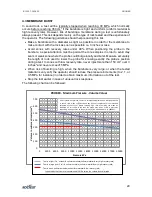
27
E10037-180424
PROBEX
4.6
COLD / HOT TEMPERATURE
In order to use the PROBEX at temperatures below 0°C, water in the probe must be replaced
by an antifreeze solution. Two types of antifreeze can be considered.
Ethylene-glycol-based antifreeze (regularly used in engine antifreeze liquid) is less
corrosive for the equipment. A 50-50 solution of water - ethylene glycol by volume will allow
using the equipment at about -25°C, a 70-30 solution can be used down to about -10°C.
Ethylene glycol is not environment-friendly. Methanol-based antifreezes (car windshield
liquid) are sometimes used, but note that methanol is corrosive for the equipment. The
equipment must be flushed and washed with clean water after each use.
When temperature drops below 0°C, we suggest using a heated shelter or minivan-type
truck in which the operator can run the pump and readout. With this configuration, it should
be possible to run tests down to at least -15°C. At some point not determined yet, between -
20°C and -40°C, the oil will get too viscous and the tubing too brittle.
The PROBEX can also be used at hot temperature (over 40 °C). However always keep
the PROBEX out of direct sun. The use of a canopy is ideal.
Try to avoid significant thermal changes on the probe. If inevitable, let the probe stabilize in
temperature at the testing depth for about 15 minutes before starting a test.
4.7
REFERENCES
(1) ASTM (2003). 2003 Annual Book of ASTM Standards, Section 4: Construction, Vol. 04.08 : Soil and Rock (1) :
D4719-00, 898
– 906.
(2) Failmezger R. A., Zdinak A. L., Darden J. N. and Fahs R. 2005.
Use of rock pressuremeter for deep foundation
design
, ISP5, Vol. 1, 469-477.
(3) Gill D. E. and Leite M. H. 1995.
Dilatometer Testing of Rock.
ISP4, Balkema, Rotterdam, 249-256.
(4) ISRM (April 1987).
Suggested Method for Deformability Determination Using a Flexible Dilatometer
, Int. J. Rock
Mech. Min. Sci., 24 (2), 123-134.
(5) Kaneshiro J. Y., Harding R.C., Johannesson P. and Korbin G.E. 1987.
Comparison of modulus values obtained
from dilatometer testing with downhole seismic surveys and unconfined compressive tests at McKays Point Dam
Site, Ca
, 28
th
US Symposium on Rock Mechanics, 211-221.
(6) Labrie D., Conlon B., Anderson T. and Boyle R.F. 2004,
Measurement of insitu deformability in hard rock,
Proceedings of 57
th
Canadian Geotechnical Conference, 9-16.
(7) Marcil L., Green R. and Baures T. and Boyle R.F. 2013,
The PROBEX: Over 25 Years of Experience in Measuring
Deformability of Rock,
ISP6















